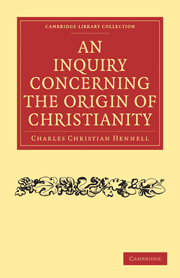Book contents
- Frontmatter
- PREFACE
- Contents
- ERRATA
- CHAPTER I Historical sketch, from the Babylonish captivity to the death of Jesus
- CHAPTER II Historical sketch, continued to the end of the first century
- CHAPTER III On the date and credibility of the Gospel of Matthew
- CHAPTER IV On the date and credibility of the Gospel of Mark
- CHAPTER V On the date and credibility of the Gospel of Luke
- CHAPTER VI On the date and credibility of the Gospel of John
- CHAPTER VII Examination of the accounts of the Resurrection and Ascension
- CHAPTER VIII Remarks on the other miracles in the four Gospels
- CHAPTER IX General objections to the miracles of Jesus
- CHAPTER X Remarks on the miracles in the Acts of the Apostles
- CHAPTER XI On the evidence afforded to the miracles by the apostolic writings
- CHAPTER XII On the prophecies
- CHAPTER XIII On the parts of Isaiah supposed to relate to Christ
- CHAPTER XIV On the book of Daniel
- CHAPTER XV Whether Jesus foretold his own death and resurrection
- CHAPTER XVI On the character, views, and doctrine of Jesus
- CHAPTER XVII Comparison of the precepts of Jesus with the Jewish writings
- CHAPTER XVIII Concluding reflections
- APPENDIX
CHAPTER I - Historical sketch, from the Babylonish captivity to the death of Jesus
Published online by Cambridge University Press: 05 March 2012
- Frontmatter
- PREFACE
- Contents
- ERRATA
- CHAPTER I Historical sketch, from the Babylonish captivity to the death of Jesus
- CHAPTER II Historical sketch, continued to the end of the first century
- CHAPTER III On the date and credibility of the Gospel of Matthew
- CHAPTER IV On the date and credibility of the Gospel of Mark
- CHAPTER V On the date and credibility of the Gospel of Luke
- CHAPTER VI On the date and credibility of the Gospel of John
- CHAPTER VII Examination of the accounts of the Resurrection and Ascension
- CHAPTER VIII Remarks on the other miracles in the four Gospels
- CHAPTER IX General objections to the miracles of Jesus
- CHAPTER X Remarks on the miracles in the Acts of the Apostles
- CHAPTER XI On the evidence afforded to the miracles by the apostolic writings
- CHAPTER XII On the prophecies
- CHAPTER XIII On the parts of Isaiah supposed to relate to Christ
- CHAPTER XIV On the book of Daniel
- CHAPTER XV Whether Jesus foretold his own death and resurrection
- CHAPTER XVI On the character, views, and doctrine of Jesus
- CHAPTER XVII Comparison of the precepts of Jesus with the Jewish writings
- CHAPTER XVIII Concluding reflections
- APPENDIX
Summary
The Jewish nation, which was of considerable political importance in the days of David and Solomon, was much weakened, during the reigns of Ahaz and his successors, by the encroachments of the Assyrians, and extinguished, for a time, as a political power, by the conquest of Jerusalem by Nebuchadnezzar. [B. C. 588.]
But the national feeling in a people of 800 years’ standing, of peculiar manners, associations, and religious worship, survives the capture of their towns; and, during each successive transportation of their tribes [B. C. 725–588], and their subsequent captivity at Babylon, the Jews consoled themselves with the hope of a speedy restoration to their own land. They compensated themselves for their present insignificance with the expectation of future greatness ; and their very sufferings were made a theme soothing to their vanity, by being considered, not as the effect of superior power on the part of their enemies, but as a paternal and corrective chastisement from their own God.
[B. C. 536.] When Cyrus permitted the small remnant of pure Jews to re-occupy their own land, and to re-build their temple and city, their most extravagant hopes seemed about to be realized. A new era opened upon them ; they were in the way to take rank again amongst the nations; and if this could be attained out of a state of general servitude, a patriotic Jew might easily believe his nation destined, in the end, to eclipse Egypt and Assyria.
Accordingly in their writings about the time of the restoration, (and a large proportion of those called the prophets appear to be nearly of that date,) these topics occur in almost every page.
- Type
- Chapter
- Information
- An Inquiry Concerning the Origin of Christianity , pp. 1 - 34Publisher: Cambridge University PressPrint publication year: 2010First published in: 1838



